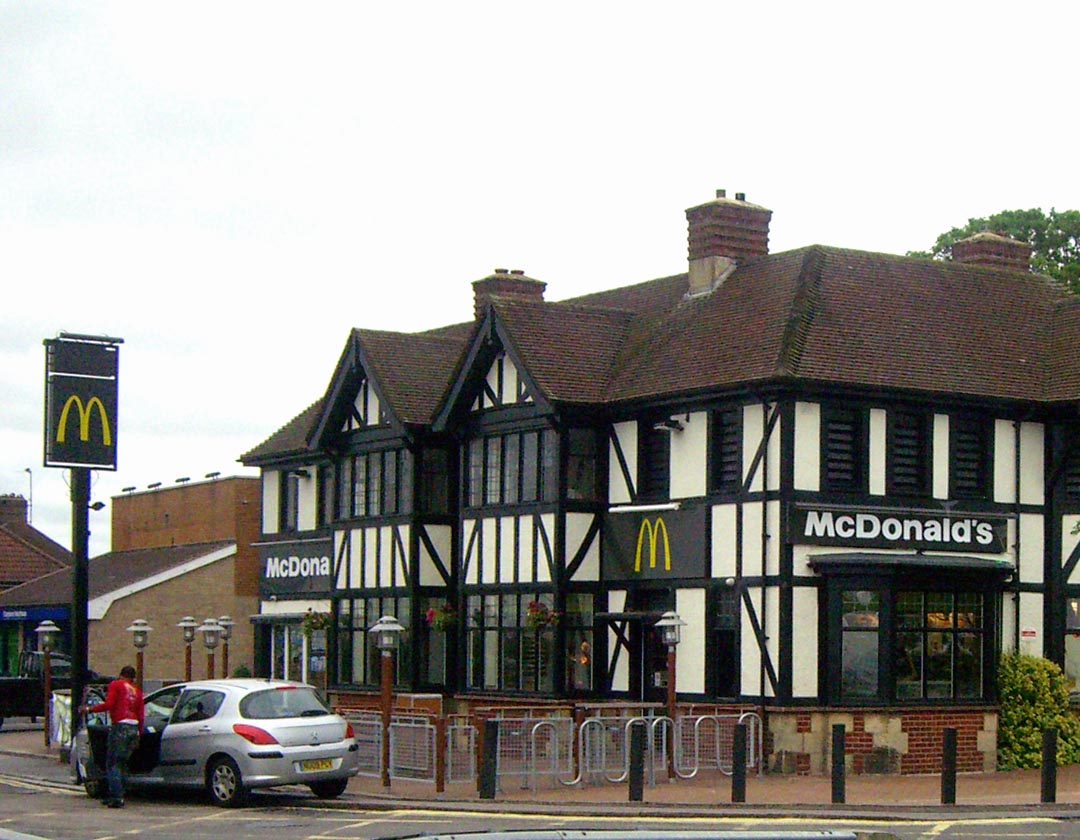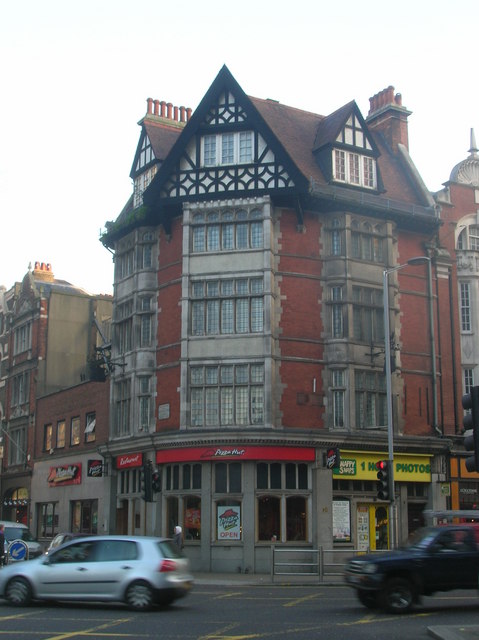Ever since our brief discussion in class regarding the use of historic buildings for modern purposes, I have been thinking a lot more about this issue and how much it bothers me! The jumping off point for our discussion was the Athens Charter and Le Corbusier’s discussion of historic sites. He points out that the old and the new must not be mixed in architecture, for do to so would be to mix the false with the genuine. I completely agree with this aspect of his views. In housing, I get very annoyed when new homes are built in a historic or ‘retro’ style. Kelowna’s Kettle Valley is a perfect example – 21st century homes built to look hundreds of years old in architectural design!
To me, the most visible example of mixing the historic with the modern is the use of historical sites for fast food restaurants. The phenomenon of ‘fast food’ has only come into existence in the last half-century or so, and to me it is one of the ultimate symbols of our modern, 21st century age. Fast food is a revolution (and not necessarily a good one!), not only in the food industry but in the entire habit of food consumption. Even 60 years ago, there was no way to receive a (grease-laden) burger and fries in a matter of seconds. Even more radically modern is the possibility of purchasing this food from the comfort of one’s automobile thanks to the invention of the drive thru. Fast food is an ultimate symbol of the fast-paced, yet sedentary, lifestyle that has become the norm in our modern, technological world. Now, I am not opposed to fast food as such – to be honest, I quite enjoy a McDonald’s Double Quarter Pounder or Wendy’s Baconator from time to time! However, I get downright upset when I see fast food restaurants in historic buildings. In my mind, the placement of McDonalds restaurants in centuries-old marvels of architecture is to violate the sanctity of these historic sites, which have stood the test of time, and impose on them something from our modern era. This blatant blend of the historic and the modern is an outright violation of this ancient architecture.
Let fast food restaurants be placed in modern-style buildings, and I wish them all the success in the world! I have no bone to pick with them. But please, let the historical buildings of our world remain historic, preserved in all their glory as relics of a by-gone era. To convert them into nothing more than a peddler of fast food, an iconic symbol of the modern age, is a serious degradation.
McDonalds – Budapest, Hungary
 McDonalds near London, England
McDonalds near London, England
 Pizza Hut – Kensington High Street, London, England
Pizza Hut – Kensington High Street, London, England
SOURCES FOR IMAGES:
– http://www.google.ca/imgres?q=mcdonalds+in+old+buildings&um=1&safe=active&hl=en&as_qdr=all&biw=1342&bih=555&tbm=isch&tbnid=WP6Oa61i1j-syM:&imgrefurl=http://andrewandnikkioverseas.blogspot.com/2013/06/more-budapest-buildings.html&docid=YdUo9vHJtu0PBM&imgurl=http://2.bp.blogspot.com/-J2sB3v8tMBU/UbSZVFS17WI/AAAAAAAADLk/gY3mEd2_vJo/s1600/P1160085.JPG&w=1200&h=1600&ei=KJptUti7CqXxigKko4GgBQ&zoom=1&ved=1t:3588,r:71,s:0,i:298&iact=rc&page=5&tbnh=189&tbnw=133&start=64&ndsp=17&tx=83&ty=113
– http://www.google.ca/imgres?q=mcdonalds+in+london&um=1&safe=active&hl=en&as_qdr=all&biw=1342&bih=555&tbm=isch&tbnid=TLBfOZsB1yRerM:&imgrefurl=http://www.flickr.com/photos/waviolette/4975509970/&docid=AH55NFV2npCzrM&imgurl=https://farm5.staticflickr.com/4125/4975509970_41c674446e_o.jpg&w=1080&h=840&ei=0JptUvDlNInMiQK7qoHICg&zoom=1&ved=1t:3588,r:49,s:0,i:232&iact=rc&page=4&tbnh=179&tbnw=230&start=40&ndsp=15&tx=153&ty=107
– http://www.google.ca/imgres?q=pizza+hut+in+london&um=1&safe=active&hl=en&as_qdr=all&biw=1342&bih=555&tbm=isch&tbnid=IkEFaOc3zr0PoM:&imgrefurl=http://www.geograph.org.uk/photo/688239&docid=FA4yJsnY-iIU0M&imgurl=http://s0.geograph.org.uk/photos/68/82/688239_44272930.jpg&w=479&h=640&ei=rJptUpSGGI_viQLsmIGYAw&zoom=1&ved=1t:3588,r:13,s:0,i:116&iact=rc&page=1&tbnh=180&tbnw=149&start=0&ndsp=16&tx=52&ty=119

Though I see your point that it seems to lower the integrity and value of the buildings to stuff a grease fueled business in these spectacular pieces of architecture, I would much rather see a McDonalds in a beautiful building rather than have another plasticized hellhole constructed. Though keeping modernist enterprises separate from historical buildings would be lovely, it lacks efficiency to keep businesses out of these places. This leads me to another question also, what if the fast food joints in these buildings are actually keeping these structures from getting torn down? Many beautiful buildings are destroyed today to make way for the new and contemporary but I think using older buildings to house new modes of modern living is a compromise of sorts. Additionally, I agree that a good batch of fries and a coke is delicious on occasion and perhaps eating this not so healthy meal in such a lovely venue would elevate the experience a tad bit (one can always hope).
While I can appreciate that it may appear a little misplaced to have a fast food joint in an old fashioned building, I don’t necessarily agree with your belief that “the placement of McDonalds restaurants in centuries-old marvels of architecture is to violate the sanctity of these historic sites”. Firstly, considering that many of these establishments are located in dense historic districts, such as the Pizza Hut in downtown London, we must remember that there is a demand for fast food in these high density locations. Given that fast food restaurants will be established there anyway due to demand for cheap convenient food, I don’t mind seeing them in “historic” buildings as at least this allows them to blend in with the surroundings (as opposed to having an ultra modern looking MacDonalds dropped in the middle of a historic district). Moreover, I think it’s important to ask what would have been of these building had MacDonalds or Wendy’s not established themselves there. Would these buildings have been torn down and replaced? Ultimately I think it would be much more offensive to the “sanctity of these historic sites” if they were torn down. Lastly I think it’s also important to consider not just the MacDonalds in the historic building, but also all other buildings on the street. If you take a stroll down any number of historic streets in London, Paris, or any other major city, you’ll find that many of these “historic” buildings are now occupied by ultra modern shops (whether it be a clothing store, restaurants, or anything else). More often than not, the MacDonalds in the centuries old building is right next door to a comparable building occupied by the Gap. Do you suggest that these stores should also vacate the buildings and if so what is to become of these “historic” districts?
I kinda like it. Sure the original architects of the buildings didn’t envision their creations being prostituted to the fast food industry. But I’d rather see the buildings serving a modern purpose, like serving McChicken burgers, than being empty and functionless. Obviously it would appeal more to see the building being utilized for a more noble reason, but hell I like fast food and would like to be in close proximity to it where ever I may be in the world, whether that be Rutland or an older district of Budapest.